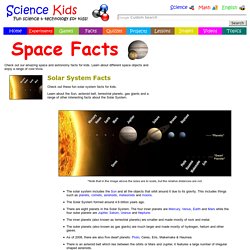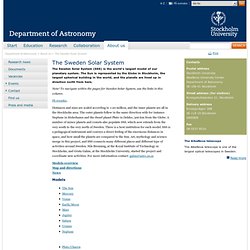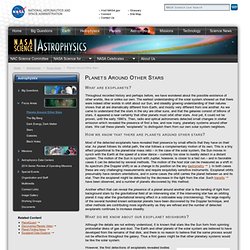

Fun Planet Facts for Kids - Cool Solar System Information & Our Amazing Planets. Fun Solar System Facts for Kids - Interesting Facts about the Solar System. *Note that in the image above the sizes are to scale, but the relative distances are not.

The solar system includes the Sun and all the objects that orbit around it due to its gravity. This includes things such as planets, comets, asteroids, meteoroids and moons. The Solar System formed around 4.6 billion years ago. KS2 Bitesize Science - Earth, Sun and Moon : Read. KS2 Science - Earth and the solar system. BBC Solar System – Discover the beauty and strangeness of space. Schools Science Clips - Earth, Sun and Moon.
Orbit / Rotation. Eyes on the Solar System. Www.solarsystemscope.com/scope.swf. Prof.Brian Cox: Why is the Earth Round - Stargazing live BBC TWO. Learning Zone Class Clips - How do we know the Earth is spherical? - Science Video. Solar System Scale Model. The planets in our solar system, in order of the nearest to the Sun. Ordering the Planets. Remembering which order the planets come in can be difficult, so why not teach your class the following tricks?

You could also ask the children to try to make up their own! (all lists should be read downwards) The International Astronomical Union have voted to change the status of Pluto. The lists at the bottom of this page are therefore no longer correct. However, they are still valuable ways of remembering the order of the planets... just remember that Pluto is now classed as a "dwarf planet". Denise Dickens also gave the following useful advice: If you get confused as to which M comes first remember, never put a Mars bar near the sun. Find more ideas and resources on our Earth and Beyond page. The Sweden Solar System - Department of Astronomy. Note!

To navigate within the pages for Sweden Solar System, use the links in this column. På svenska. Models overview Map and directions News Models The Sun Globen, Stockholm Diameter: 71 m (solar disk) + the corona (the Sun's outer atmosphere) Bild: Ludvig Ehrenstråhle The Globe Arena in Stockholm is the largest spherical building in the world, and it represents the Sun in the SSS. Up Mercury Stockholms stadsmuseum, Slussen Diameter: 25 cm Distance from Globen: 2,9 km. Planets Around Other Stars. Planets Around Other Stars What are exoplanets?

Throughout recorded history and perhaps before, we have wondered about the possible existence of other worlds, like or unlike our own. The earliest understanding of the solar system showed us that there were indeed other worlds in orbit about our Sun, and steadily growing understanding of their natures shows that all are dramatically different from Earth, and mostly very different from one another. As we came to understand that the stars in the sky are other suns, and that the galaxies consist of billions of stars, it appeared a near certainty that other planets must orbit other stars. And yet, it could not be proven, until the early 1990’s.
How we know that there are planets around other stars? Most of the detected exoplanets have revealed their presence by small effects that they have on their star. What do we know about our exoplanet neighbors? In other reports, a number of planets with masses near that of Earth have been detected. Learning Zone Class Clips - Copernicus and Galileo – the movement of the Earth - Science Video.
Planet Size Comparison. FearOfPhysics.com:Sun, Earth, and Moon in Motion. Planets - ordering and mnemonics. Solar System planets Interesting Facts for Kids. The Solar System. Our solar neighborhood is an exciting place.

The Solar System is full of planets, moons, asteroids, comets, minor planets, and many other exciting objects. Learn about Io, the explosive moon that orbits the planet Jupiter, or explore the gigantic canyons and deserts on Mars. What Is The Solar System? The Solar System is made up of all the planets that orbit our Sun. In addition to planets, the Solar System also consists of moons, comets, asteroids, minor planets, and dust and gas. Everything in the Solar System orbits or revolves around the Sun. How Did The Solar System form? This is an important question, and one that is difficult for scientists to understand. Scientists believe that the Solar System evolved from a giant cloud of dust and gas. At the center of this spinning cloud, a small star began to form.
Further away from the center of this mass where the star was forming, there were smaller clumps of dust and gas that were also collapsing. A Great Storm. Sun, Moon and Earth Orbits. Learn about our planet, our only natural satellite and our nearest star © 2012 This website is produced by the Student Recruitment, Admissions and International Development Division at The University of Manchester.
